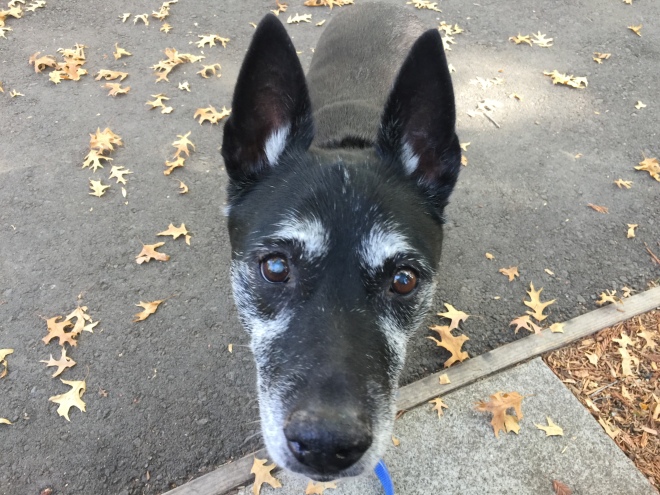
My dog Hannah kept me awake for more than two hours last night. She paced. She stood next to my bed staring at me. She softly whined. She loudly plunked her body on the hardwood floors instead of settling into her cushy memory foam bed. Between 1:30 and 3:30 AM I was up six times to see if letting her outside would help her settle down. It did not. I finally had to resort to shutting her out of the bedroom so I could get some sleep.
Hannah is 15 years old. For a dog her size, the charts peg her comparable age as a human at 83. Like most elderly folk, she has arthritis and needs pain management. However, she has the further complication of chronic liver disease, which limits her medical pain management options. Her increasingly frequent bouts of bedtime restlessness suggest she also has a mild case of canine cognitive dysfunction (AKA “doggie Alzheimer’s”).
Her care has become increasingly more and more expensive. To preserve her liver function, she needs to take a daily medication I can only get through the veterinarian that costs $93 a month. Every 6 weeks or so she gets a blood draw at the vet’s office to check her ALT, a measurement of her liver health.
For her arthritis pain, the only drug she can take is gabapentin because the NSAIDs cause her ALT to skyrocket, and that is not a good thing. Gabapentin is at least fairly cheap, costing just under $15 for 100 capsules. However, over time its effectiveness lessens, so she needs to take more and more. Currently she goes through 100 capsules about every two weeks. Then there is the cost of the supplements that provide a modicum of help: Movoflex, Dasuquin, curcumin (turmeric), and Vitamin E.
Just before Thanksgiving she woke me in the wee hours because she was vomiting in the corner of the bedroom. Then she laid down and I had trouble rousing her. I bundled her up and took her to the emergency vet. With her history, one of the first things they did was draw blood to check her liver health. Her ALT was a shocking 4,000 (normal is under 107). Only four days earlier during a routine check at the local vet it had been 273.
Since Thanksgiving, the cost of hospitalization, tests, and drugs has been just under $6,200. That includes trips to the emergency vet again over the New Year’s holiday weekend when she started shivering and panting, and whining due to discomfort or pain.
Every time a new expense pops up for her care, I question whether it is time to let her go. My measure has always been whether she is still enjoying life, and it seems to me she is. Long walks are no longer possible due to her arthritis, but she still enjoys short walks where she can explore scents. She loves riding in the car, and now that the weather is cool and often overcast, I can take her along as I drive about town to get groceries and stock up on household supplies. She watches the activities on the block through the front windows, and barks a warning whenever she sees another dog being walked past the house. She still shows interest in playing with her toys, and in her meals.
Most pet owners I know have considered what they would do if their pet was diagnosed with a terminal disease. “I won’t put my dog through chemo,” we say, because we tend to think cancer is a the most likely fatal disease our pet will face. What we fail to consider is that, like us, our pets will also face the slow decline of bodies that are wearing out.
How can I justify to myself withdrawing supportive care for Hannah dog’s pain? Or refuse to treat the infection that suddenly flared up in her liver nearly eight weeks ago?
How can I find the energy to push through the days following nights of interrupted sleep? And how can I keep paying the vet bills?

In 25 years of owning dogs, and 5 dogs later, this question has never gotten easier to answer. I’m so sorry you’re entering this stage, it’s never easy. We’ll be looking at that, ourselves, soon. And you’re right, their comfort is primary but you also have to be able to pay the bills as well, without bankrupting yourself or endangering your financial position. *hugs*
LikeLike
Sounded like you were talking about my mom for a second. She’s 84, also has severe arthritis, is on gabapentin. It’s worth the extra work but at some point, more treatments will not improve quality of life and my loved had the ability to communicate it. She relented to having valve replacement surgery this year only because it was the path of least suffering of her two options. She said she’d rather die on the table than be in pain and hospitalized over and over for what remains of her life. So I guess that is the question you must answer during your next health crisis. What is the path of least suffering because at that age, it’s probably what your loved one wants.
It’s a scary time for sure and not easy to make those decisions. You are stronger than you think. You will be able to get through this.
LikeLike
Pingback: Sister sucker punch – Windycitygal
Pingback: Money talk: how owning a house can bring in passive income – Windycitygal